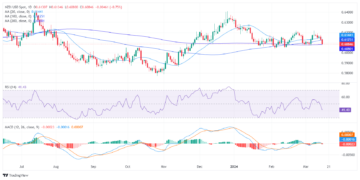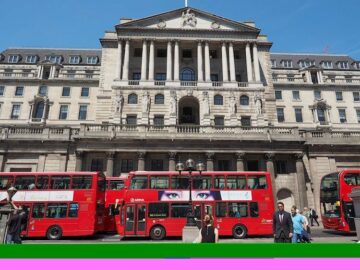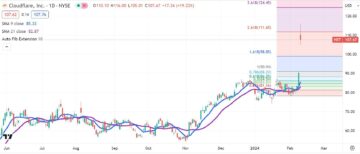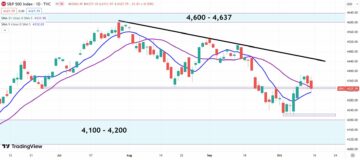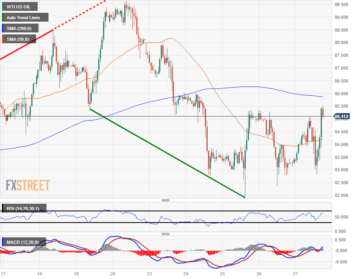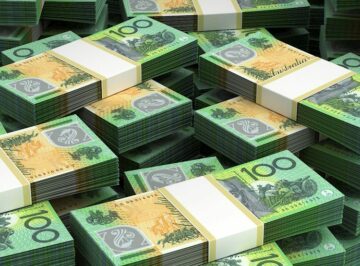
- Mexican Peso experiences some volatility to start the week, though it resumed its gains of more than 0.20%.
- Banxico’s Governor Victoria Rodriguez Ceja’s comments on potential rate cuts next year add pressure on the Mexican Peso.
- USD/MXN traders shrug off dovish remarks by Banxico’s Governor Victoria Rodriguez Ceja, which sees potential rate cuts in 2024.
Mexican Peso (MXN) posts gains against the US Dollar (USD) after data revealed by the New York Fed showed inflation is cooling, according to US households, on Monday. At the time of writing, the USD/MXN is trading at 17.59, down 0.22%, after hitting a daily high of 17.72.
Mexico’s economic docket is empty following last Thursday’s Bank of Mexico – also known as Banxico – decision to hold rates at 11.25% while removing hawkish comments from its statement, which weighed on the Mexican Peso. Dovish remarks by Banxico’s Governor Victoria Rodriguez Ceja kept the USD/MXN trading downward pressured, but investors shrugged off Rodriguez’s comments, as the exotic pair trended lower, printing a daily low of 17.57.
The US economic docket released the New York Fed Inflation Expectations survey. According to the data, American households estimated inflation for one year at 3.6% in October, which was slightly below last month’s figure of 3.7%. The five-year inflation outlook dipped to 2.7% from the previous reading of 2.8%.
Daily digest movers: Mexican Peso remains range bound despite market sentiment shifting sour
- Banxico’s Governor Victoria Rodriguez commented that the easing inflationary outlook could pave the way for discussing possible rate cuts. She said that monetary policy loosening could be gradual but not necessarily imply continuous rate cuts, adding that the board would consider macroeconomic conditions, adopting a data-dependent approach.
- Industrial production in Mexico cooled down, according to data provided by the National Statistics Agency (INEGI) on November 10. The output grew by 3.9% YoY in September, below the 4.4% forecast, trailing August’s 5.2%.
- The latest inflation report in Mexico, published on November 9, showed prices grew by 4.26% YoY in October, below forecasts of 4.28% and prior rate of 4.45%. On a monthly basis, inflation came at 0.39%, slightly above the 0.38% consensus and September’s 0.44%.
- Last Thursday’s hawkish remarks by the US Federal Reserve Chairman Jerome Powell sponsored the USD/MXN a leg up, toward 17.93, before paring some losses.
- Mexico´s economy remains resilient after October’s S&P Global Manufacturing PMI improved to 52.1 from 49.8, and the Gross Domestic Product (GDP) expanded by 3.3% YoY in the third quarter.
- Banxico revised its inflation projections from 3.50% to 3.87% for 2024, which remains above the central bank’s 3.00% target (plus or minus 1%).
Technical Analysis: Mexican Peso remains steady despite Golden Cross surfacing, USD/MXN stays in the green
The USD/MXN remains neutral to upward biased, at a brisk of breaking crucial resistance levels, like the 200-day Simple Moving Average (SMA) at 17.66, followed by the 50-day SMA at 17.70. Once those two levels are breached, the next resistance would emerge at the 20-day SMA at 17.91 before buyers could lift the spot price towards the 18.00 figure.
Conversely, key support levels lie at 17.50, followed by the November 9 low at 17.47 and the 100-day Simple Moving Average (SMA) at 17.33. A loss of the latter will expose the 17.00 psychological level before the pair aims to test the year-to-date (YTD) low of 16.62.
Interest rates FAQs
Interest rates are charged by financial institutions on loans to borrowers and are paid as interest to savers and depositors. They are influenced by base lending rates, which are set by central banks in response to changes in the economy. Central banks normally have a mandate to ensure price stability, which in most cases means targeting a core inflation rate of around 2%.
If inflation falls below target the central bank may cut base lending rates, with a view to stimulating lending and boosting the economy. If inflation rises substantially above 2% it normally results in the central bank raising base lending rates in an attempt to lower inflation.
Higher interest rates generally help strengthen a country’s currency as they make it a more attractive place for global investors to park their money.
Higher interest rates overall weigh on the price of Gold because they increase the opportunity cost of holding Gold instead of investing in an interest-bearing asset or placing cash in the bank.
If interest rates are high that usually pushes up the price of the US Dollar (USD), and since Gold is priced in Dollars, this has the effect of lowering the price of Gold.
The Fed funds rate is the overnight rate at which US banks lend to each other. It is the oft-quoted headline rate set by the Federal Reserve at its FOMC meetings. It is set as a range, for example 4.75%-5.00%, though the upper limit (in that case 5.00%) is the quoted figure.
Market expectations for future Fed funds rate are tracked by the CME FedWatch tool, which shapes how many financial markets behave in anticipation of future Federal Reserve monetary policy decisions.
- SEO Powered Content & PR Distribution. Get Amplified Today.
- PlatoData.Network Vertical Generative Ai. Empower Yourself. Access Here.
- PlatoAiStream. Web3 Intelligence. Knowledge Amplified. Access Here.
- PlatoESG. Carbon, CleanTech, Energy, Environment, Solar, Waste Management. Access Here.
- PlatoHealth. Biotech and Clinical Trials Intelligence. Access Here.
- Source: https://www.fxstreet.com/news/mexican-peso-struggles-for-direction-on-risk-off-mood-dovish-banxicos-tone-202311131604
- :has
- :is
- :not
- ][p
- $UP
- 1
- 10
- 11
- 16
- 17
- 2%
- 2024
- 28
- 32
- 33
- 49
- 50
- 66
- 70
- 72
- 8
- 9
- 91
- a
- above
- According
- add
- adding
- Adopting
- After
- against
- agency
- aims
- also
- American
- Amid
- an
- analysis
- and
- Animate
- anticipation
- approach
- ARE
- around
- AS
- asset
- At
- attempt
- attractive
- average
- Bank
- Banks
- base
- basis
- BE
- because
- before
- behave
- below
- biased
- board
- boosting
- borrowers
- bound
- Breaking
- but
- buyers
- by
- came
- case
- cases
- Cash
- central
- Central Bank
- Central Banks
- chairman
- Changes
- charged
- CME
- commented
- comments
- conditions
- Consensus
- Consider
- content
- continuous
- Core
- core inflation
- Cost
- could
- country’s
- Cross
- crucial
- Currency
- Cut
- cuts
- daily
- data
- decision
- decisions
- depositors
- Despite
- Digest
- discussing
- Dollar
- dollars
- Domestic
- Dovish
- down
- downward
- each
- easing
- Economic
- economy
- effect
- emerge
- empty
- ends
- ensure
- estimated
- example
- Exotic
- expanded
- expectations
- Experiences
- Falls
- FAQ
- Fed
- fed funds rate
- Federal
- federal reserve
- Federal Reserve Chairman
- Figure
- financial
- Financial institutions
- Firm
- followed
- following
- FOMC
- For
- Forecast
- forecasts
- from
- funds
- future
- Gains
- GDP
- generally
- Global
- Gold
- Golden
- golden cross
- Governor
- gradual
- grew
- gross
- Have
- Hawkish
- headline
- help
- High
- hitting
- hold
- holding
- households
- How
- HTTPS
- if
- improved
- in
- Increase
- inflation
- Inflation expectations
- inflation rate
- Inflationary
- influenced
- instead
- institutions
- interest
- Interest Rates
- investing
- Investors
- IT
- ITS
- jerome
- jerome powell
- jpg
- kept
- Key
- known
- Last
- latest
- LEND
- lending
- Level
- levels
- lie
- like
- LIMIT
- Loans
- loss
- losses
- Low
- lower
- lowering
- Macroeconomic
- make
- mandate
- manufacturing
- many
- Market
- market sentiment
- Markets
- May..
- means
- meetings
- Mexico
- module
- Monday
- Monetary
- Monetary Policy
- money
- Month
- monthly
- mood
- more
- most
- Movers
- moving
- moving average
- National
- necessarily
- Neutral
- New
- New York
- New York Fed
- next
- normally
- November
- october
- of
- off
- on
- once
- ONE
- Opportunity
- or
- Other
- Outlook
- output
- overall
- overnight
- paid
- pair
- Park
- pave
- Peso
- Place
- placing
- plato
- Plato Data Intelligence
- PlatoData
- plus
- pmi
- policy
- possible
- Posts
- potential
- Powell
- pressure
- previous
- price
- Prices
- printing
- Prior
- Product
- Production
- projections
- provided
- psychological
- published
- pushes
- Quarter
- raising
- range
- Rate
- Rates
- Reading
- released
- remains
- removing
- report
- Reserve
- resilient
- Resistance
- response
- Results
- Revealed
- Rises
- s
- S&P
- S&P Global
- Said
- Savers
- sees
- sentiment
- September
- set
- shapes
- she
- SHIFTING
- showed
- shrug
- Simple
- since
- SMA
- some
- Sponsored
- Spot
- Stability
- start
- starts
- Statement
- statistics
- steady
- Strengthen
- substantially
- support
- support levels
- Survey
- Target
- targeting
- test
- than
- that
- The
- The US Federal Reserve
- their
- they
- Third
- this
- those
- though?
- time
- to
- tool
- toward
- towards
- Traders
- Trading
- two
- upbeat
- upward
- us
- US Dollar
- US Federal
- us federal reserve
- USD
- usually
- Victoria
- View
- Volatility
- was
- Way..
- week
- weigh
- which
- while
- will
- with
- would
- writing
- year
- york
- zephyrnet

